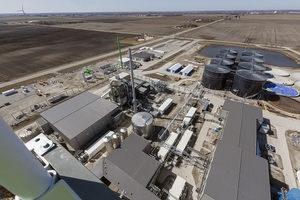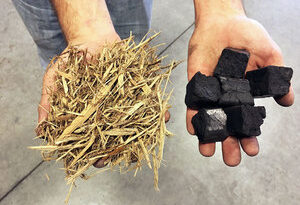Q&A: Finding New Niches
Energy Disrupter
Enviva is expanding into new markets, furthering its mission of decarbonization via sustainable woody biomass.
ADVERTISEMENT
It was nearly 20 years ago that Enviva was founded, and over the past couple of decades, the company has amassed a portfolio of 10 operating wood pellet plants with a production capacity of 6.2 million metric tons per year. Several more are in various stages of development, and the company also owns, operates and exports pellets out of deep-water marine terminals at the Port of Chesapeake, Virginia; the Port of Wilmington, North Carolina; and the Port of Pascagoula, Mississippi. Directly employing about 1,100, Enviva sells most of its wood pellets through long-term, take-or-pay off-take contracts customers in countries including the United Kingdom, the European Union and Japan. While Enviva’s roots are in helping transition fossil fuel heat and/or power plants to wood pellets, the company is finding additional niches in assisting hard-to-abate sectors including steel, cement, lime, chemicals and aviation. Biomass Magazine briefly caught up with Thomas Meth, cofounder, president and CEO of Enviva, about the company’s momentum.
BMM: The wood pellets-to-heat-and/or-power space has been Enviva’s mainstay since its inception. What new and emerging markets are you expanding into to further global decarbonization efforts?
Meth: Enviva is the largest producer of sustainably sourced wood pellets in the world. Historically, Enviva has primarily delivered our renewable, drop-in energy substitute for coal to power and heat generators across Europe and Japan. Today, we are seeing an ever-increasing demand for our product beyond heat and power, as the war in Ukraine continues and Russian gas becomes obsolete for much of the world. In the last one to two years alone, there has been growth in demand for our product across hard-to-abate industries, such as lime, steel, cement and asphalt, and their decision to take a close look at defossilizing their production facilities and supply chains.
The potential applications for our product have dramatically increased and are more realistic today than ever before. With cellulosic biofuels from biomass being a notable part of the Renewable Fuel Standard, we see a path to utilizing the biomass industry’s existing or planned installed capacity to accelerate renewable liquid fuel production, most notably sustainable aviation fuel (SAF) to meet the SAF Grand Challenge. We are seeing positive tailwinds across the following industries.
• Power and Heating: We have active discussions to add European contracts as the late-stage offtakes roll off—approx. 2 million metric tons per year (MTPY).
• SAF: Three contracts are already signed with companies in the U.S. and U.K., with continued discussions around 4 million MTPY potential ramping from 2027. In addition, we completed test deliveries to two major oil companies in Europe that are constructing biorefineries and coprocessing biobased feedstock in their existing refineries.
• Aggregates (lime, cement and asphalt): We are having active discussions for approximately 2 million MTPY of potential, ramping up from 2025.
• Methanol: Discussions are active, with approx. 1 million MTPY in potential starting in 2025-‘26; methanol-powered vessels have been ordered.
• Metals and mining: We have ongoing discussions with an approx. 5 million MTPY of potential in 2027- ’28.
• Carbon sequestration: Contracts are already signed, with additional discussions for an approx. 5 million MTPY potential starting in 2030.
BMM: In the past, Enviva has labeled itself as a wood pellet producer and supplier—it seems you have expanded your self-description, particularly when it comes to the supply of SAF feedstocks. Can you explain?
Meth: As it pertains to Enviva, we will supply wood biomass feedstock derived from the least merchantable, low-value wood from a traditional timber harvest, such as forest byproducts like tree tops, limbs and commercial thinnings. Depending on the customer’s contract, this may or may not be delivered in pellet form. Other variations could include wood chips and processed sawdust.
BMM: What are some of the unique benefits (for renewable liquid fuels producers) of biomass as a feedstock?
Meth: Biomass for renewable liquid fuels producers provides a clear path to reducing historical reliance on crude oil. As already proven in the power and heating industries, biomass as a feedstock has been demonstrated to reduce liquid fuel carbon emissions on a lifecycle basis and provides a sustainable and renewable resource for transportation fuels. Other key benefits include increased energy security through domestically sourced biomass and waste reduction through the use of agricultural waste, including forestry residue, contributing to a more circular economy.
BMM: The U.S. EPA’s biointermediate provisions—which were released last year as a way to expand the feedstock pool for renewable fuels—will they impact the biomass sphere in any way?
Meth: Yes, we saw it as a great sign of growth and opportunity for the U.S. market. Historically, Enviva’s business has been export-driven, with a limited domestic customer base. The EPA’s revised provisions provide a way for potential biomass customers to utilize biointermediates to meet their goals of reducing biofuel production costs and expand opportunities for more cost-effective cellulosic biofuels–like woody biomass.
Recognizing the scaling up of SAF is critical to meeting the U.S.’s aggressive climate goals, the White House launched the SAF Grand Challenge, with goals to have 3 billion gallons of SAF produced in the U.S. by 2030 and augmenting to 35 billion gallons by 2050. Recently, we have been encouraged by the actions taken by Congress and the White House (i.e., $1.7 trillion omnibus spending bill and the U.S. Inflation Reduction Act) about the potential for a significant domestic market in the near future. The passage of the Inflation Reduction Act into law amplifies the U.S. commitment to SAF by providing tax credits for every gallon of SAF produced based on lifecycle greenhouse gas emission reduction percentages. Further, the IRA extends and modifies the tax credit for the production of renewable energy from biomass and other technologies.
Europe is pursuing similar policy initiatives such as ReFuelEU, with the European Parliament voting in support of draft rules to require SAF to account for at least 85% of European Union aviation fuel by 2050. Similarly, the United Kingdom announced the introduction of an SAF mandate, requiring at least 10% of jet fuel to be produced sustainably by 2030.
BMM: What’s the most challenging component right now, when it comes to decarbonization via sustainable biomass?
Meth: Like many other industries today, we must ensure industry’s operational cost position remains low in a world of inflationary pressures and higher interest rates. Simultaneously, we must continue to grow and scale sustainably to meet the ever-insatiable demand of our product as wood biomass continues to play an ever-important role in stabilizing and defossilizing power and heat generation across the globe.
















